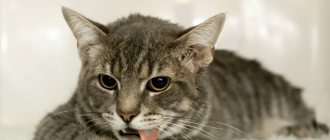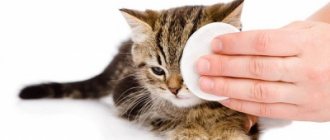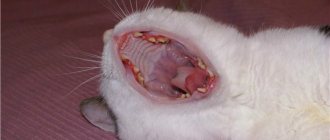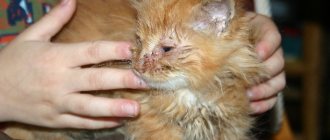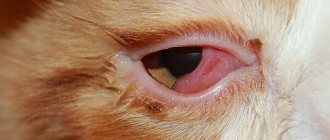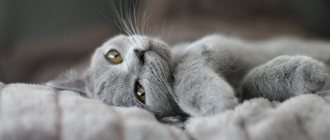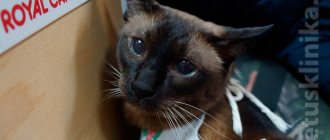Ascites is dropsy of the abdominal cavity in cats. The idea that this is a separate disease is erroneous. Ascites develops against the background of a chronic pathology that has developed in the body, and is characterized by the accumulation of fluid in the abdominal cavity, which exceeds normal levels.
Excess intrauterine fluid puts pressure on the internal organs, making it difficult for them to function. The process is dangerous because dangerous complications, including death, will arise in the pet’s body.
Why does ascites develop?
Absolutely any animal can suffer from ascites, but cats that lead a sedentary lifestyle are most susceptible to this pathological condition. A small volume of serous fluid is always present in the abdominal cavity.
Excessive fluid volume above normal poses a danger to the body.
Excessive accumulation of fluid in the abdominal cavity can be caused by the following factors:
- cardiovascular pathologies;
- renal failure;
- liver diseases;
- decreased albumin levels;
- hepatitis;
- diabetes;
- tuberculosis;
- peritonitis;
- infections, parasites, fungi;
- weak immunity;
- overweight;
- hormonal imbalances;
- oncology;
- abdominal injuries that provoked an inflammatory process in the abdominal cavity;
- bladder rupture;
- nephrotic syndrome;
- excess salt in the diet, economy-class food and, as a result, an increase in sodium concentration;
- violation of water-salt and protein metabolism.
This is not a complete list of the reasons leading to abdominal dropsy in cats.
Symptoms of flatulence
Loud sounds and unpleasant odors when a cat passes gas are the main symptoms of flatulence. However, this process is not always accompanied by a stench. Other signs may indicate problems with the digestive tract.
How to tell if your cat has gas
- The cat's stomach growls loudly.
- Pain in the stomach area. The cat won't let you touch its belly.
- Stomach bloating in a cat.
- The cat farts often.
- Hiccups.
- Diarrhea and gases suddenly released from the anus.
- Vomit.
- Muscle spasms in the abdominal area.
- The cat is worried and meows loudly and pitifully in pain.
- The animal hides and does not allow itself to be touched.
Bloating, vomiting, diarrhea and flatulence may indicate other problems with the animal's gastrointestinal tract. Take your cat to the veterinarian for a diagnosis and treatment.
Clinical picture
The initial stage of the pathological condition is virtually asymptomatic, since the accumulation of fluid in the abdominal cavity is a gradual process. Characteristic signs can only be noticed when the volume of fluid significantly exceeds normal levels. Ascites can be suspected by a noticeably swollen abdomen and stretching of the sides when the animal is active.
Symptoms:
- the abdominal cavity is swollen, hard to the touch;
- fluctuation - when pressing on the abdomen, you can feel the liquid inside it swaying;
- the belly takes on the shape of a pear when the cat stands on its hind legs, and inflates and rounds when taking a sitting position;
- dullness and disheveled fur;
- yellowish tint of mucous membranes;
- paws, ears, crotch, sternum swell;
- vomiting, nausea;
- lack of appetite;
- constipation or diarrhea;
- breathing problems, hoarseness, shortness of breath;
- weakness, apathy.
It is very important to distinguish ascites from ordinary overeating.
Bacterial infection of the deep layer of skin
Occurs when microbes enter deep into the dermis.
Read also: Dog dandruff on fur and skin
Furuncle
First, a painful node appears, then an abscess matures in its center. After 5–7 days it opens, a purulent-necrotic core is released, and the wound is scarred. When there is more than one lesion, they speak of furunculosis.
Carbuncle
These are several boils united into a common infiltrate. The place looks like a purple-bluish tumor. Pain increases, well-being suffers, body temperature rises. After opening the formation, a deep ulcer remains, healing with a scar.
Acne (blackheads)
- inflammation of the sebaceous gland ducts due to blockage. Pustules form on the face, chest, and shoulders. Their contents dry out to crusts, after which, when rejected, scars or bluish spots remain.
Hidradenitis
Purulent inflammation of the sweat glands. The process often recurs. Favorite localizations are armpits, inguinal folds, under the mammary glands. Deep painful nodes appear, bluish-red on the outside. They are opened with the separation of liquid pus.
Read also: 5 secrets of delicious kebab
Erysipelas
Occurs in people who are individually predisposed. Foci of inflammation are clearly limited. The affected area is swollen, hot, bright red, with bursting blisters. The disease is accompanied by fever, intoxication, and severe pain.
Deep pyoderma can be complicated by inflammation of the lymphatic vessels and nodes, abscess, and sepsis.
Diagnostics in a veterinary clinic
The diagnostic task is to differentiate ascites from other diseases with similar symptoms, for example, from exudative peritonitis. Thus, with peritonitis, an increase in temperature, pain when pressing on the abdomen, and a significant number of leukocytes and proteins are observed.
And finally, the most obvious sign of peritonitis is the transience of the disease. With ascites, as mentioned above, the disease has a long development.
Necessary diagnostic methods for suspected ascites include:
- taking anamnesis;
- analysis of clinical symptoms;
- palpation of the abdominal cavity;
- urine and blood tests;
- X-ray of the peritoneum, sternum;
- Ultrasound of the chest and abdominal cavity;
- fluid examination;
- endoscopy;
- biopsy.
Differential diagnosis helps to identify the underlying pathology that caused ascites. Without determining the provoking factor, it is impossible to prescribe adequate treatment, since the amount of fluid will increase with each relapse.
Prevention
Prevention of a bloated abdomen in a cat, as well as any other serious pet disease, comes down to following the rules for keeping cats in an apartment:
- It is necessary to regularly treat worms: kittens - once a month, adult cats - once every 3 months throughout their lives.
- Follow the principles of proper animal nutrition. If you are not sure about the chosen feeding tactics, make an appointment with a veterinary nutritionist: the doctor will be able to select not only ready-made food, but also a balanced homemade diet.
- It is advisable not to allow pets to walk outside to avoid infection with the feline infectious peritonitis virus, for which there is currently no vaccination.
- It is necessary to install special “anti-cat” nets on the windows, which prevent not only falling out of the window, but also getting stuck in windows open for ventilation.
Can ascites in cats be treated or not?
Treatment of ascites is carried out comprehensively. Therapy is aimed at eliminating the underlying disease, alleviating pain symptoms and strengthening the immune system.
To reduce the amount of fluid in the abdominal cavity, laxatives and diuretics (Furosemide, Temisal) are indicated.
To stabilize the functioning of the cardiovascular system, drugs such as Olitorizide, Strophanthin, Digitoxin, Cardiovalen are necessarily prescribed.
If there is an infection in the body, antibiotic therapy using drugs from a number of cephalosporins is indicated.
To strengthen the walls of blood vessels and reduce their permeability, the veterinarian prescribes intravenous solutions of calcium chloride (10%).
To pump out the fluid, a puncture is done when the veterinarian pierces the abdominal wall. The procedure is performed at least twice a week. In this case, the removal of ascitic fluid must be compensated by reinfusion of ascitic transudate or administration of an albumin solution. These procedures provide a chance for additional remission and prolongation of the animal’s life.
The course of treatment depends on the condition of the animal and the amount of fluid. This is a long process that must continue until the clinical signs of dropsy completely disappear.
As for the prognosis, with adequate and, most importantly, timely therapy, it is favorable. If you do not seek help from a specialist in time, the volume of fluid will continue to increase, and this is fraught with pressure on the internal organs and disruption of their functions.
When to urgently contact a veterinarian
Most often, excessive gas formation, frequent release of gases does not require the intervention of veterinary specialists.
A visit to the veterinarian is necessary if these symptoms are accompanied by others:
- bloody diarrhea;
- vomit;
- decreased appetite;
- complete refusal to eat;
- painful bloated stomach;
- restless cat behavior.
The doctor must examine the animal, give it the correct diagnosis, and prescribe the necessary treatment.
What should the owner do
Under no circumstances should you play Aibolit or give your pet medications without consulting a veterinarian. Only a specialist can prescribe medications and set their dosage, based on the severity of the pathology, general condition and age of the animal.
Uncontrolled use of medications can lead to potassium being excreted from the body along with urine. This will worsen the cat’s well-being and lead to complications, even to the point where the animal dies. Human diuretics are especially dangerous in this regard.
Increasing their dosage independently can lead to disturbances in the level of electrolytes and leaching of fluid from the microcirculation network. This is fraught with the possible development of encephalopathy.
At the first opportunity, you should take the animal to the clinic so that the doctor can examine it and prescribe appropriate treatment.
A cat with abdominal hydrops is prescribed a therapeutic diet that involves limiting the consumption of water and any other liquid. The food of a sick pet should be nutritious, balanced in vitamins, minerals and carbohydrates and consist mainly of proteins.
The diet includes meat, poultry, sea fish, cottage cheese, kefir. You can add salt to food, but the amount of salt should be minimal.
Treatment
Treatment of the underlying disease is necessary if it is identified.
There are several rules to reduce the symptoms of bloating:
- Try to feed your cat more often, in small portions, in a calm environment to prevent aerophagia. If you have several animals competing for food, feed them separately in different rooms. It is possible to use special bowls that prevent the rapid swallowing of food;
- make sure the food is fresh, dry food must be in a tightly closed bag, in a bowl for no more than a day, wet food and homemade diet are removed as soon as the cat finishes eating;
- block the cat's access to the trash can;
- Choose a cat food that is low in fiber and highly digestible, or consult a veterinary nutritionist. You may need a therapeutic diet (prescribed by a veterinarian).
Possible causes of bloating
Next, we will consider the possible causes of a hard abdomen in a cat, conditionally dividing them into non-dangerous and dangerous (i.e., life-threatening for the pet).
Non-hazardous conditions
- Obesity is the scourge of modern domestic cats. Locked within four walls, cats do not hunt and move little, making obesity almost inevitable. Abundant deposits of subcutaneous fat in the abdominal area of a cat can form not only folds, but also a voluminous large belly.
- Pregnancy is a normal physiological process during which the pet's abdominal cavity increases significantly. Of course, this condition occurs only in females. Pregnancy often comes as a surprise to cat owners, especially if the pet ran outside the day before or you picked it up recently. Pregnancy in cats lasts about two months. If the cat has a large belly, but you are sure that she is not pregnant, it is still necessary to do an ultrasound of the abdominal cavity to exclude an “interesting” position.
- Flatulence, or bloating, can be classified as both non-dangerous and (in advanced cases) and dangerous conditions. Most often, this condition occurs when the pet is suddenly overfed (this often happens if we take a hungry cat from the street), when feeding spoiled food or giving food that is unsuitable for the cat (for example, a large portion of milk for a cat that is not used to drinking it).
Dangerous conditions
- Viral diseases that can lead to bloating. For example, infectious peritonitis is a dangerous, contagious and difficult to treat disease.
- Neoplasms , such as lymphoma, often produce effusion into the abdominal cavity and, as a result, a distended abdomen. Despite the fact that such conditions are most often incurable, timely diagnosis and chemotherapy can extend the pet’s life by several years.
- Heart disease can lead to something called congestive heart failure, which can cause fluid to accumulate in both the chest and abdomen.
- Coprostasis , or constipation, is a common problem in domestic cats. When the condition is neglected, the abdomen of cats and kittens enlarges, thickens, becomes inflated and hard. Unfortunately, enemas do not always help in such conditions, and surgery may be required.
- Kidney failure caused by diseases such as chronic kidney disease. In advanced cases, it can also lead to hydrops of the abdominal cavity, manifested by bloating in cats and kittens.
- Liver diseases , such as lipidosis and cirrhosis, cause blood to pool in the abdomen and result in ascites (dropsy), causing the cat's belly to become distended.
- Injuries , most often associated with a fall from a height, can lead to damage to the spleen, large vessels and other organs, causing internal bleeding and rapid enlargement of the abdomen.
- Pyometra , or purulent inflammation of the uterus, is very common in adult unsterilized cats, especially after the use of hormonal drugs to stop heat. It is for this reason that all cats are recommended to be sterilized.
- Worm infestation is much more common than domestic cat owners might imagine. In advanced cases, parasites can clog the intestinal wall, cause perforation of its wall, peritonitis and, as a result, the cat will have a painful, hard stomach.
Lipoma
This is a benign formation consisting of adipose tissue. In essence, it is a local accumulation of adipose tissue under the skin. Lipoma is a benign tumor, although in rare cases, liposarcoma, a malignant formation, can develop under its mask.
Lipomas manifest themselves in the form of soft-elastic subcutaneous formations, mobile, painless, and can slowly increase in size. The skin over lipomas is not changed and easily moves over them. Small lipomas are not visible at all; they can only be detected by palpation. Larger lipomas stand out as “bumps” of round or oval shape. The size of lipomas is very variable - from 1-2 cm to 20 cm or more. Lipomas never become inflamed or suppurate.
Probability of death
The likelihood of death depends on the situation. The exact indicator is determined only by diagnostic results.
Remember that complications are possible even with non-hazardous factors. The bloating puts pressure on the chest, preventing normal breathing. There is also a high risk of gastric volvulus, intestinal rupture, tissue necrosis and sepsis. To avoid unpleasant consequences, contact your veterinarian if you have any alarming symptoms.
